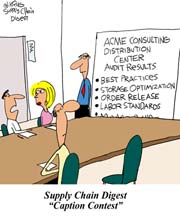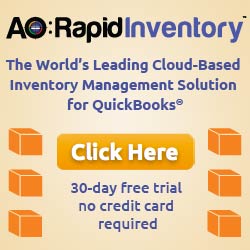 |
August 23, 2012 - Supply Chain Newsletter |
 |
This Week In SCDigest
FEATURED SPONSOR – AO: Rapid Inventory |
| Start Free Trial Now! The World's Leading Cloud-Based Inventory Management Solution for QuickBooks® |
|
|
||||||||||||||||||||||||||||||||||||||||||||||||||||
Tuesday's Videocast:
Achieving Powerful Results at Medtronic with SAP Enterprise Inventory Optimization

Detailed Case Study Supported by Educational Overview of Inventory Optimization Software
Featuring Tim Boos, Sr. Program/Project Manager, Medtronic, Dave Strothmann, Senior Director, SCM Business Development, SAP
New Videocast:
Predictive Analytics and Perfect Logistics Execution -
The Future of the Consumer Goods to Retail Supply Chain

Part 1: Understanding Predictive Analytics in the Consumer Goods to Retail Supply Chain
Featuring Mark Krupnik of Retalon and
Greg Holder of Compliance Networks
MAJOR RESEARCH PROJECT
Last Chance! Survey Closing Soon
Important Research on US
Manufacturing and Reshoring
MIT and SCDigest Need Your Help!

Participants Receive New Report from MIT's
Dr. David Simchi-Levi, Copy of Results and More
Can you please help by taking this quick 15 minute survey? All respondents will receive a summary of the data
in just a few weeks.
We are admittedly way behind on Feedback, but this week we are going ahead and publishing several of the strong number of emails we have received on David Schneider's guest First Thoughts column last week on "The One Best Supply Chain Metric." That piece argued that Operating Cash Flow (OCF) is the most meaningful and potentially transforming metric that can be used.
We've exceeded the usual number of responses for a FT's piece, somewhat depressing SCDigest editor Dan Gilmore, but he is trying not to dwell on it.
The Feedback of the Week is from our friend Kevin O'Meara, former AMR Research executive now involved in a number of other pursuits. He very much likes the concept. A couple of others aren't so sure.
| Feedback of the Week: On One Best Supply Chain Metric - | |
I have a saying which I tell my finance people all the time when I ask them for cash flow metrics: "A P&L / income statement becomes 'impure' as soon as an accountants hands touch it!". The maneuvering over what is capitalized and what is not, what will be accrued for and what is not etc. etc. makes it almost (I am obviously embellishing here to make a point) a fictional document. Cash flow tells you what is really happening. And, cash flow from operations (versus financial and investing) is the king metric for a supply chain manager. May I make a suggestion: Run a series of articles which starts with just what is cash flow, what are the three and how are they calculated. Then it would go into why (in more detail) it is so important and finally what are some things a supply chain manager can do to improve it. For example, a supply chain manager would have a far better appreciation of the trade off of transportation cost v. speed to market if they understood the impact on operating cash flow when they compress the cash to cash cycle. So many I have seen will go for a lower transportation cost even at the expense of a much longer cash to cash mainly because they are measured on expense and have no accountability to OCF. Anyway, just my thoughts. A great article and I would love to see more. Kevin O'Meara I understand the value of measuring OCF but, if used as a metric or goal, how do you reconcile when cash is used to pay down debt or make a major purchase? That will drive down the OCF but not because of poor performance. Dwayne A Wildhagen C.P.I.M. Editor's Note: What I believe David is saying is that you only measure OCF that is impacted by the supply chain, not financial activities such as you suggest. No doubt, this could require some special accounting efforts. Many companies also do report cash flow from operations separate from financial and other areas. Dan Gilmore I do not buy all of what you are suggesting here. So much of what happens on the sales front can impact the supply chain. Using OCF has so many variables that it would cause to much debate in this company. Rick Sawyer Editor's Note: Same basic answer as the above letter. Agree if those other factors cannot be separated out there are issues. Great for you to cover such a topic. I have been on this theme for awhile. Large corporates have to act as a bank, whether they want to or not. Too many external forces are driving us this way. Banks, in being the primary originators of trade finance assets, are facing challenges like never before. Revisions to capital based regulation (Basel Accords) as well as changing regulations (Dodd Frank and FASB accounting regulations among others) are creating significant balance sheet pressures. David Gustin
|
|
SUPPLY CHAIN TRIVIA ANSWER
Q: What do former companies RGTI, KRAM, Logisticon, and PCS have in common?
A: All were one time important players in the Warehouse Management Systems market, circa 1990 to 2000 or so. All have been acquired or gone away since, but in some cases there is still current software out there that can be traced to the products these companies developed.
| © SupplyChainDigest™ 2003-2012. All Rights Reserved. SupplyChainDigest PO Box 714 Springboro, Ohio 45066 |
POWERED BY: XDIMENSION |






